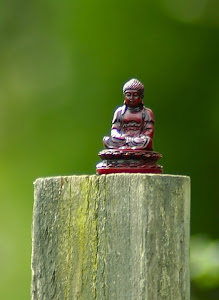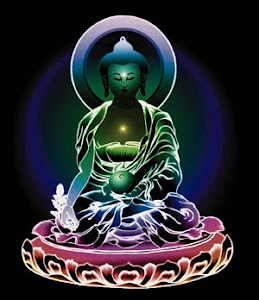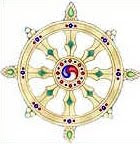The Differences Between Mahayana and Theravada School in Buddhism
>> Thursday, February 25, 2010
Emerge Of Mahayana and Theravada School
As we look at the history Of Buddhism, it seems Buddhism was founded by Guatama the Buddha / Shakyamuni Buddha. It was originated in Jambudiipa / India
After the Parinibbaana of the Buddha in about the 100 years of the Era, the disciples of the Buddha held another rehearsal; at that time Buddha’s teaching was interpreted in various ways. As a result Buddhism was divided into several schools and sub-schools, after the manifestation of the schisms. The original Sangha reassembled forming several groups, two of which became firmly established in the five hundred years following. They are known as Sthavira and Mahasanghika.[1]
Sthavira
According to Bhikshu Thich Thien Chau – in the second council “Who contested the five propositions and the majority (Mahasamghikas) who approved them.”[2]
On the other hand, in the Sthavira School
The two sub-Schools of Sthaviras are: Sarvaastivaadins, Sautraantikas & Kaaśyapas. According to this Scholar he also says:
“The orthodox Sthavira were henceforth known as Vibhajyavaadins in order to distinguish them from their adversaries.”[5]
Later on Theravaadins develop in Ceylon
Mahasanghika
Mahasanghika is one of the early schools. After one hundred years after the 1st Buddhist Council, at the 1st Century B.C. to the 1st century A.D., at this period the two terms Mahayana and Theravada emerged or appeared. The Mahaasaa.nghika sect was formed in the first Buddhist schism around 320 B.C.E.
As we talk furthermore, in Mahayana school, they developed into two periods, as Early Development of the Mahayana sect and late development of the Mahayana sect. So the early development of the Mahayana sect was emerged during the second century after the Buddha’s death, it seems that this sect was split up into many sub-schools as Ekavyaahaarika[6], Kukku.tika (Gokulika), Bahuśrutiiya and Praj~nptivaada and shortly after wards appeared the Saila schools.[7] The Caityakas were so called because of their cult of the caityas (shrines). Both of them paved the way for the growth of Mahaayaanism.[8]
On the other hand, when we look at the late development of the Mahayana School India India to South East Asia and towards the north to Central Asia and Far East . At the early time than in India , the influence of the Mahayana in China
Basic contradictory Philosophy of Mahayana & Theravada
Here I will show the contradictory Philosophy of Mahayana and Theravada schools and how they differ from each other. Also I will show in below the different Philosophy of the both Schools Mahayana and Theravada.
Mahayana | Theravada |
Bodhisattva ideal - Mahayana is for the Bodhisattvahood which leads to Buddhahood. | Arahantship – The Buddha, Pacceka Buddha, & disciples are called Arehants free from defilesments & cycle of birth and death (Samsara). |
Here these three are called the Bodhis | |
They rejected certain portions of the canon which had been accepted in the first Councial, and did not recognize, as the Buddha’s sayings (Buddhavacana), the Parivaara, the Abhidhamma, the Patisambhidaa, the Niddesa and parts of the Jaatakas. They don’t accepted these three things as Buddhavacana.[11] | Here they did not change and accepted Buddhavacana as Buddha words. |
Bodhisattva Concept - The ideal of the Mahayana school is that of the Bodhisattva, a person who delays his or her own enlightenment in order to compassionately assist all other beings and ultimately attains to the highest Bodhi. [12] In Mahayana Concept all Bodhisattva which is enlightened One from Raga, Dosa. | Bodhisattva Concept – here it teaches for the welfare of the people should seek their own salvation. The Theravada considers a Bodhisattva as a man amongst us who devotes his entire life for the attainment of perfection, ultimately becoming a fully Enlightened Buddha for the welfare of the world, for the happiness of the world. |
Concept Of Buddha - The Buddhas are considered to be lokottara (supramundane) and are connected only externally with the worldly life. This conception of the deification of the Buddha contributed much to the growth of the Mahayana philosophy. According to them the Buddhas are lokottara (supramundane); they have no saasrava dharmas (defiled elements); their bodies, their length of life and their powers are unlimited; they neither sleep nor dream; they are self-possessed and always in a state of samadhi (meditation); they do not preach by name; they understand everything in a moment (ekaksanika-citta); until they attain parinirvana, the Buddhas possess ksayaj~naana (knowledge of decay) and anut-paadaj~naana (knowledge of non-origination). In short, everything concerning the Buddhas is transcendental. The Mahasanghika conception of the Buddhas contributed to the growth of the later Trikaaya theory in Mahayana. Thus the Mahasanghikas conceived of the Buddha decetically and gave rise to the conception of the Bodhisattvas. | Concept Of Buddha - The Buddhas are considered to be lokottara (supramundane). |
Viewpoint on Meditation - The Mahayana school gave more emphasis on meditation especially the | Viewpoint on Meditation – They say ‘ Samadhi, meditation, is to be attained by means of one or other of the forty objects of meditation. The Purpose of this meditation is to keep one’s mind perfectly balanced so that it may be possible to gain a proper insight into the real nature of things. This is done by cultivating insight (Praj~naa).[14] The cultivation of Praj~naa helps one to understand at one and the same time the …,’ fundamental teachings in Theravada Buddhism. |
Sunyata - Some people think that Voidness or Sunyata discussed by Nagarjuna in his remarkable book; Madhyamika Karika is purely a Mahayana teaching. But it is actually based on the idea of Anatta or non-self, non-attachment and also on the Paticcasamuppada or the Dependent Origination, found in the original Theravada Pali texts.[15] Mahayana Buddhism is emptiness (sunyata), which is ... referred to as suchness (tathata), the body of essence (dharma-kaya) or even nirvana.[16] | Sunyata - Here they talk about the idea of Anatta or non-self, non-attachment and also on the Paticcasamuppada.[17] |
Philosophy of Mahayana – here they also have some of the principles are same like the Theravadins, accept the cardinal principles of Buddhism, and were, in this regards, not different from them.
- The Fundamentals are the four noble truths, the eightfold path, the non-existence of the soul, the theory of karma, the theory of pratiitya-samutpada, the thirty-seven Bodhipaksiya-dharmas, and the gradual stages of spiritual advancement.
- Here when they talk about the consciousness in Mahayana; they have one main Consciousness that is ‘Alaya consciousness’. They believe under this one all other consciousnesses are store on it.
- They also beliefs that: the five Vij~n.naanas (sense-perceptions) conduce both to saraaga (attachment to worldly matters) and viraaga (non-attachment to the same state).[18]
- The rūpendriyas (organs of sense are more flesh. They themselves cannot perceive the vij~n.naanas of the organs.)[19]
- One can eliminates suffering and obtain the highest bliss (nirvana) through knowledge (praj~n.naa).[20]
- A srotapanna (one who has entered the path of sanctification) is liable to retrogress while an that is not. He is capable of knowing his own nature (svabhava) through his citta and caitasika dharmas. He is also liable to commit all kinds of offences except the five heinous crimes (pa~ncaanantayaani), namely, matricide, patricide, the murder of an Arahant, shedding the blood of the Buddha and creating a split in the Sangha.[21]
- Nothing is indeterminate (avyaakrita), i.e., the nature of things must be either good or bad for it can not be neither good nor bad. That’s to say Non-duality.[22]
- The original nature of the mind is pure; it becomes contaminated when it is stained by upaklesa (passions) and Œgantukarajas (adventitious defilements). [This view of the Mahaasanghikas may be considered the precursor of the idealistic philosophy of Yogaacaara, in which the AAlayavij~naana is the storehouse of pure consciousness which becomes impure only when it is polluted by worldly objects.][23]
- After death and before rebirth a being has no existence.[24]
Thus Mahasanghikas (Mahayana) differ considerably from other sects in doctrinal matters as well as in their rules of disciples’ line. The followers of the schools wore a yellow robe, the lower part of which was polled tightly to the left.[25]
Philosophy of Theravada –
- All worldly phenomena are subject to three characteristics- they are anity, or impermanent and transient; duhkha or full of sufferings; and anaatma, that is there is nothing in them which can be called one’s own, nothing substantial, nothing permanent.[26]
- All compound things are made up of two elements naama, the non-material part, and rūpa, the material part.
- They are further described as consisting of nothing but five constituent groups (skandhas),…
- These elements are also classified into twelve organs, & objects of sense (AAyatanaani) and eighteen dhaatus.
- In the later classification, one must add six consciousness to the list of the twelve AAyatanas,… and thus arrive at eighteen dhaatus.
- The number of the constituent increases gradually from two to five, then twelve, and finally to eighteen.
- In Abhidhammaṭṭha-saṅgaha (about 8th – 12th centuries A.D.) of the psycho-ethical philosophy of School, … gives the following as the four ultimate categories: consciousness (citta), mental properties (caitasika), material qualities (rūpa), and nirvaa.na. Consciousness is further classified into eighty-nine types (a hundred and twenty-one types according to another classification), mental properties into fifty-two, and material qualities into twenty-eight. Nirvaa.na is a happy state which is free from passion, ill-will and delusion; in reality it is a state which is beyond description.[27]
Difference in Attainment in Mahayana & Theravada
- There are several ways in which Mahayana Buddhism differs from Theravada Buddhism.
- Perhaps the most prominent difference is their views on salvation and liberation.
- In Mahayana they believe: three types of Buddhahood: the Samma Sambuddha who gains full Enlightenment by his own effort, the Pacceka Buddha who has lesser qualities than the Samma Sambuddha, and the Savaka Buddha who is an Arahant disciple.[28]
- They believe the attainment of Nibbana between the three types of Buddhahood is exactly the same. The only difference is that the Samma Sambuddha has many more qualities and capacities than the other two.[29]
- Theravada is considered to be somewhat of a “selfish” religion because it focuses on total self-reliance to reach Nirvana.
- On the other hand, Mahayana Buddhists believe in helping each other reach enlightenment.
- Bodhisattvas, although prevalent in both sects, take on different roles in both Theravada and Mahayana Buddhism.
- Theravada Buddhists view Bodhisattvas as merely a guide in helping to reach individual enlightenment, while Mahayana Buddhists see Bodhisattvas not as a command for individual perfection, but to save all beings from suffering.
- In Theravada, they believe - No distinction is made between nibbana attained by a Buddha and that of an Arahant or Pacceka-buddha.
- Also known as 'liberation from Samsara,' there are subtle distinctions in the level of attainment for the three situations.
- The main goal of Theravada Buddhism is personal liberation from suffering and that of Mahayana Buddhism is liberation of all living beings from suffering.[30]
So here those are the differences that Mahayana and the Theravada School
Conclusion
According to my opinion I believe that The Mahayana - The Great Vehicle. This form of Buddhism emerged somewhere between 150 BCE and 100CE. Its distinctive features include the new emphasis given to compassion and the Bodhisattva ideal, the three-bodies of the Buddha doctrine, emptiness and skill in means.
In Mahayana Buddhism the Bodhisattva - Enlightenment Being, this is a being whose Buddhahood is assured but who postpones his/her own entry into Nirvana to help all other sentient beings attain to it first. The Buddha himself was described as a Bodhisattva in stories of his previous lives.
In Theravada sect - The Theravada school of Buddhism
In Buddhism Arahant (Noble one) is an arahant is an individual who has realized Nirvana, brought an end to his own suffering and the cycle of birth and death. Nirvana (to cease blowing) – In both school Nirvana is the ultimate goal of Buddhism, the third noble truth. In nirvana, the suffering and the desire that causes suffering have come to an end, as has the cycle of birth and death. Sometimes nirvana is referred to by the Buddha as 'unborn' and 'unconditioned', in contrast to the phenomenal world we experience in our unenlightened state.
Theravada and Mahayana traditions share many basic principles, practices, and institutional structures. Theravada more unified, coherent tradition based on conservation of early teachings (Pali Canon). Mahayana more diverse; inspired by new body of scriptures and new Buddha/bodhisattva cults. Mahayana represents itself as a ‘higher’ path. Mahayana has an expanded conception of the Buddha, distinctive teachings and texts (especially bodhisattva ideal), and a more diverse sangha.
On the other hand, Mahayana Buddhism evolved in East Asia giving rise to many new traditions. Theravada preserved in Southern Asia .
[1] Lee, Yuan Chin, Elder, Ven. Dharma Master Lok To, Sutra Translation Committee of the U.S. & Canada, New York – San Francisco – Toronto, 1995
[2] Chau, T. T. Bhikshu, Wayman, A., The Literature of the Personalists of Early Buddhism, Motilal Banarsidass Publishers Private Limited, Delhi
[3] The original Vatsiputriyas seem to have remained in the East, settling in Kosala, Varanasi and being (as were the Sammitiyas) one of the early schools which still flourished in the homeland of Buddhism in the time of the Pala Empire (8 - 12th centuries A.D.)
[4] Chau, T. T. Bhikshu, Wayman, A., The Literature of the Personalists of Early Buddhism, Motilal Banarsidass Publishers Private Limited, Delhi
[5] Ibid. P. 03
[6] This school also known as = Lokottaravaadins, emerged 200 years after the passing away of the Buddha.
[7] Bapat, Prof. P. V., 1956, 2500 Years of Buddhism, The Publication Division, Delhi
[8] Ibid. P. 112
[10] Urbandharma, Ven. Dr. W. Rahula, http://www.urbandharma.org/udharma3/theramaya.html -Viewed on 10/12/2009
[11] Bapat, Prof. P. V., 1956, 2500 Years of Buddhism, The Publication Division, Delhi -8, P. 110
[12] Ibid Viewed on 10/12/2009
[13]Buddhistdoor, Ankur Barua, http://mingkok.buddhistdoor.com/en/news/d/2482 - Viewed on 21/11/2009
[14] Bapat, Prof. P. V., 1956, 2500 Years of Buddhism, The Publication Division, Delhi -8, P. 102
[15] Ibid, Viewed on 21/11/2009
[16]LYCOS RETRIEVER, http://www.lycos.com/info/mahayana-buddhism--theravada-buddhism.html - Viewed on 22/11/2009
[17] Urbandharma, Ven. Dr. W. Rahula, http://www.urbandharma.org/udharma3/theramaya.html - Viewed on 11/12/2009
[18] Bapat, Prof. P. V., 1956, 2500 Years of Buddhism, The Publication Division, Delhi -8, P. 115
[19] Ibid, P. 115
[20] Ibid. P. 115
[21] Ibid, P. 115
[22] Ibid, P. 115
[23] Ibid, P. 115
[24] Ibid, P.115
[25] Ibid, P. 115
[26] Ibid, P. 102
[27] Ibid, P. 102-103
[28] Urbandharma, Ven. Dr. W. Rahula, http://www.urbandharma.org/udharma3/theramaya.html - Viewed on 21/11/2009
[29] Ibid, Viewed on 21/12/2009
[30] Buddhistdoor, Ankur Barua, http://mingkok.buddhistdoor.com/en/news/d/2482 - Viewed on 12/12/2009
The End












